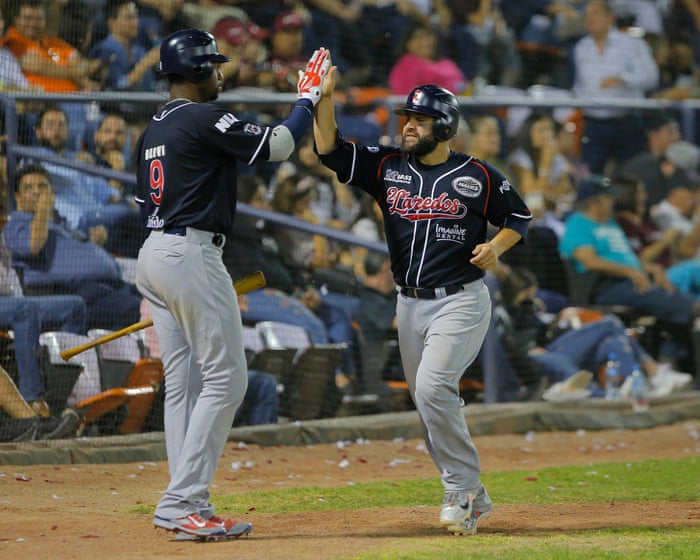The differences between watching a baseball game in the US and Mexico are impossible to ignore. While the rules on the field are the same, the atmosphere in Mexican stadiums is lively, filled with music, noise, and an infectious energy. The fan cultures are so distinct that if you dropped a blindfolded supporter into either crowd, they’d likely know within seconds which side of the Rio Grande they were on—or so you’d think. But reality is never that simple.
Despite heated political debates about borders, they rarely have clear-cut divisions. This is especially true in South Texas—and not just as a poetic notion. Even the most obvious sign of crossing a border, a checkpoint with customs officers, can be found 50 miles from the actual boundary. The Rio Grande may mark where Mexico and the US officially begin and end, but the river also sits at the heart of economies, communities, and lives that stretch across both banks. Living with one foot in Laredo (US) and the other in Nuevo Laredo (Mexico) is so ingrained here that it’s even reflected in the name of the cities’ beloved baseball team: los Tecolotes de los Dos Laredos (the Two Laredos Owls).
Like many things in border regions, the team—affectionately called los Tecos—embodies multiple identities. As their name suggests, they play home games on both sides of the border, making them Mexican, American, and, above all, a symbol of the blended experience that thrives in the space between the two.
“The US-Mexican border is an open wound where the Third World grates against the First and bleeds,” wrote Gloria Anzaldúa, a scholar and South Texas native whose book Borderlands/La Frontera is a landmark work on the subject. “The lifeblood of two worlds merges to form a third country.” To many, this “third country” is the cultural zone known as La Frontera (the border).
People on either side of many borders often share more in common with each other than with their own country’s heartland. That’s the case along the Rio Grande, making los Tecos something like La Frontera’s unofficial national team. But first and foremost, they represent the two Laredos.
“Yes, there are fans in Matamoros, Reynosa, Piedras Negras [other border cities],” says Juan Alanis, a media official and play-by-play broadcaster for los Tecos. “But the core, the heart of the fanbase, is in the two Laredos… there’s history here.”
Los Tecos play in the Liga Mexicana de Béisbol (LMB), a 20-team league spanning Mexico from Tijuana to Cancún. While there’s no exact way to compare baseball leagues globally, the LMB is often ranked among the world’s top six domestic competitions—below MLB and Japan’s NPB but arguably on par with or better than leagues in Korea, Venezuela, and the Dominican Republic. (Mexico also has a winter league, which some consider the country’s highest level of play.)
One thing is certain: until the 2021 restructuring of minor league baseball, the LMB was classified as a AAA league—equivalent to the second-highest tier in the US. It’s also older than any other non-US league mentioned, now celebrating its 100th anniversary.
And los Tecos have been part of it for most of that history.
(Note: The last sentence about Guardians pitcher Emmanuel Clase appears incomplete, so it has been omitted for coherence.)Mexican Baseball Team Tecolotes Bridges Two Nations
While Mexican baseball teams move between cities as often as their U.S. counterparts, the Tecolotes (or “Tecos”) have called either Laredo or Nuevo Laredo home for most seasons since the 1940s. Though the current team is technically the third franchise to carry the Tecos name, fans don’t dwell on such details.
“The whole place was a party,” recalls Ricardo Ábrego, a 58-year-old carpenter from Nuevo Laredo, describing the Tecos’ 1977 championship win (two franchises ago). He attended the game with his extended family and still smiles at the memory. With a plush Tecos mascot peeking from his shirt pocket, Ábrego is the definition of a superfan. When asked what the team means to him, he simply says, “Todo” (everything), then proudly lists their championship history.
With five titles, the Tecos rank among the Mexican League’s most successful teams—comparable to the Detroit Tigers in MLB, both in postseason success and their northern border location. This legacy, combined with decades of local presence, has made Tecos fandom a family tradition.
“I’ve always loved them—my grandfather did too,” says 23-year-old factory worker Eduardo Espino. “For us, it’s baseball over soccer. I think it’s because we’re fronterizos—part of the border culture.”
Espino embodies the team’s binational identity. Though he lives in Nuevo Laredo, most of his childhood Tecos memories are from games in Texas. Yet he prefers the atmosphere on the Mexican side.
“Fans in Nuevo Laredo are more emotional,” Espino explains. “The stands are packed, and the energy is just… more.” Fellow fans Ábrego and broadcaster Alanis agree—there’s an unspoken preference for Nuevo Laredo’s older stadium among supporters.
“I love both, but the crowd here is fiercer, more passionate,” says Alanis. “But always respectful. If the opposing team makes a great play, fans applaud.” This isn’t just talk—during games, Tecos fans on both sides cheer opponents’ defensive efforts, showcasing their shared sportsmanship.
Yes, Nuevo Laredo’s stadium is louder (thanks partly to a hand-cranked siren), but to an outsider, games in both cities feel more alike than different.
On both sides of the border, plays—even early strikes—are met with a whirl of matracas (wooden noisemakers) and airhorns.
“In Mexico, unlike MLB, there’s constant noise until the pitcher winds up,” says Alanis. “With the pitch clock, the DJ knows he has 10 seconds to play music. It’s just how we do it.” The soundtrack? A mix of English classics (Michael Jackson, Creedence Clearwater Revival) and border favorites (Selena, Grupo Frontera), blaring until the very last second before the pitch.Here’s the rewritten version in fluent, natural English:
—
As the pitcher begins his windup, the music constantly fades in and out, which can feel overwhelming at times. But with so many fans dancing and singing between pitches, it clearly adds to the lively atmosphere—and, as everyone mentioned earlier, there’s definitely more dancing in the crowd at games in Nuevo Laredo.
Beyond the sounds, attending an LMB game blends the best parts of both major and minor league baseball in the U.S. Like the minors, a Tecos game is affordable and family-friendly—parking is free, and just four dollars gets you a hot dog and a small beer, even at the Laredo stadium. But like the majors, LMB games have in-stadium replays on the big screen and plenty of passion. Pitchers celebrate strikeouts with fist pumps, and fans watch nervously, hands clasped in prayer. This mix of minor and major league energy appeals to both players and fans.
“It’s been fun—everywhere I’ve played has been great,” says Stephen Gonsalves, a pitcher for the visiting Charros de Jalisco who previously played for the Boston Red Sox and Minnesota Twins. Gonsalves is part of a growing number of U.S. players choosing the LMB. “There are fewer jobs back home,” he adds, referring to the 2020 cuts in minor league teams. “Now, you see a lot of older veterans who’ve played in the big leagues. Every team has at least three or four former MLB players. The competition is solid.”
LMB players also seem to have a better quality of life than minor leaguers. “Minor league baseball was a grind,” says Andrew Pérez, another Charros pitcher who spent six years in the White Sox organization, including time in Triple-A. “Back then, you’d have eight guys crammed into an apartment.” Now, the biggest hassles for players like Pérez and Gonsalves are the frequent border crossings and hotel stays during away games in the two Laredos (home games alternate between them). This back-and-forth is a common complaint for visiting teams—and might even give los Tecos a home-field advantage.
For most residents of both Laredos—including the Tecos—crossing the border is just a routine part of life, like toll roads or public transit in other cities. Recent media coverage might make it seem like there’s some new crisis, but for locals, it’s business as usual. Everyone interviewed for this article said they hadn’t noticed any major changes at the border lately and seemed almost amused by my questions. Here, the border has always been part of daily life—and will be long after the media moves on.
By calling both Laredos home, los Tecos embody an older, unified Laredo that existed long before the U.S.-Mexico border split it in the 19th century. Along the Rio Grande, national borders feel temporary compared to the deep roots of families and communities in the area. Los Tecos reflect that reality. Walking back across the bridge to the U.S. after the game in Nuevo Laredo (the CBP officer, a fan, asks about the score), the river looks surprisingly small.
—
The rewritten version keeps the original meaning while improving flow, simplifying phrasing, and removing unnecessary complexity. Let me know if you’d like any further refinements!




